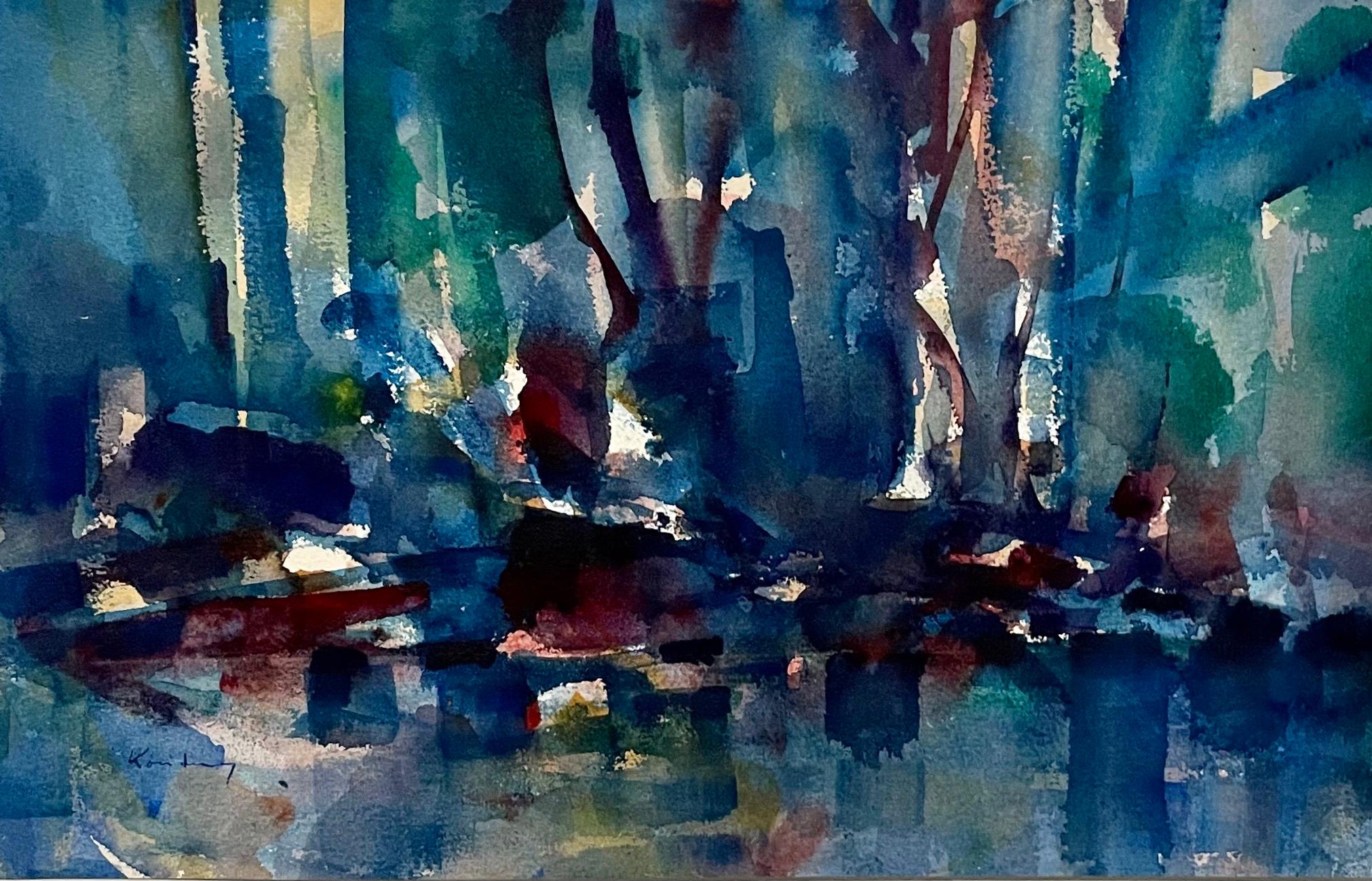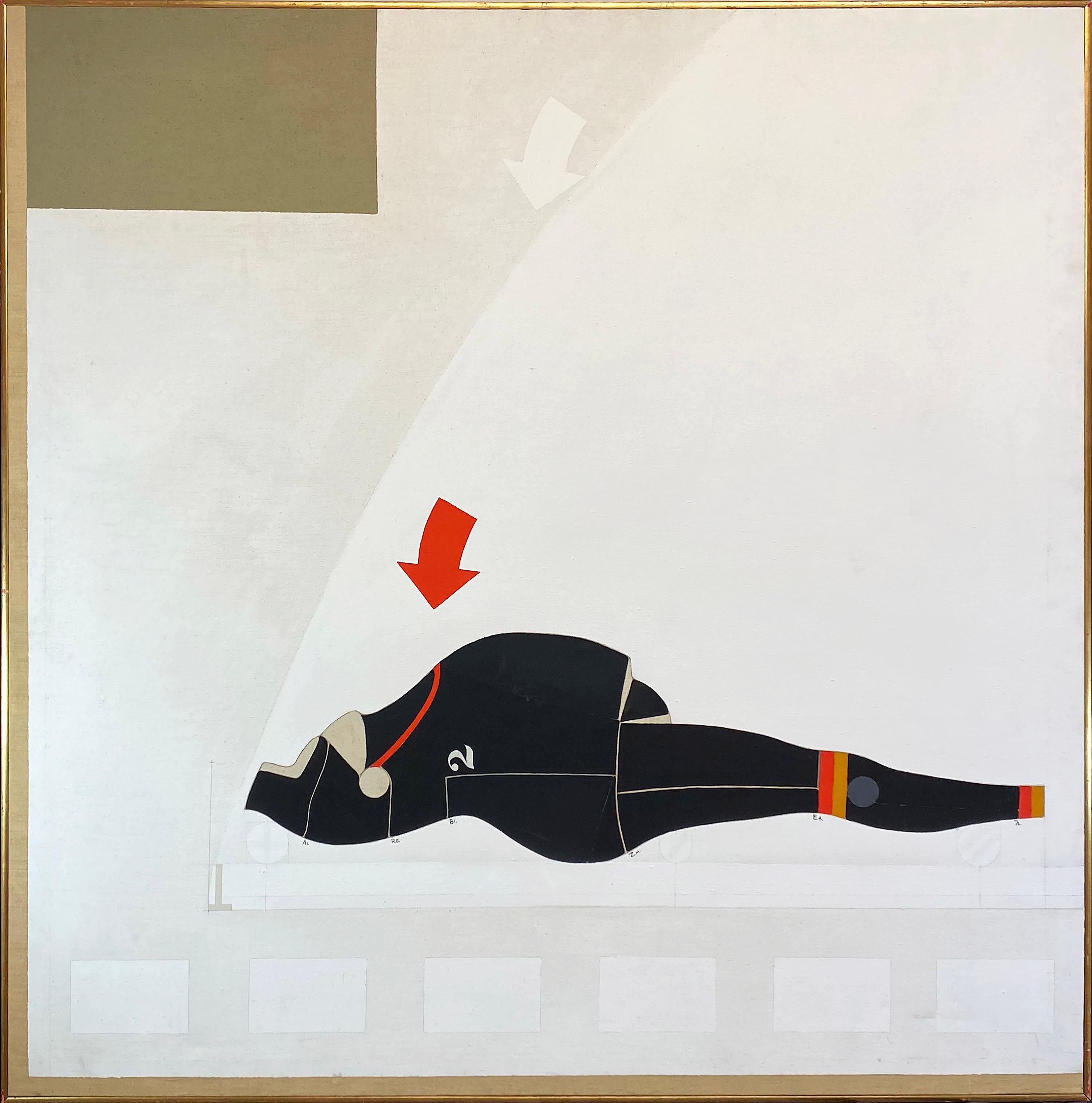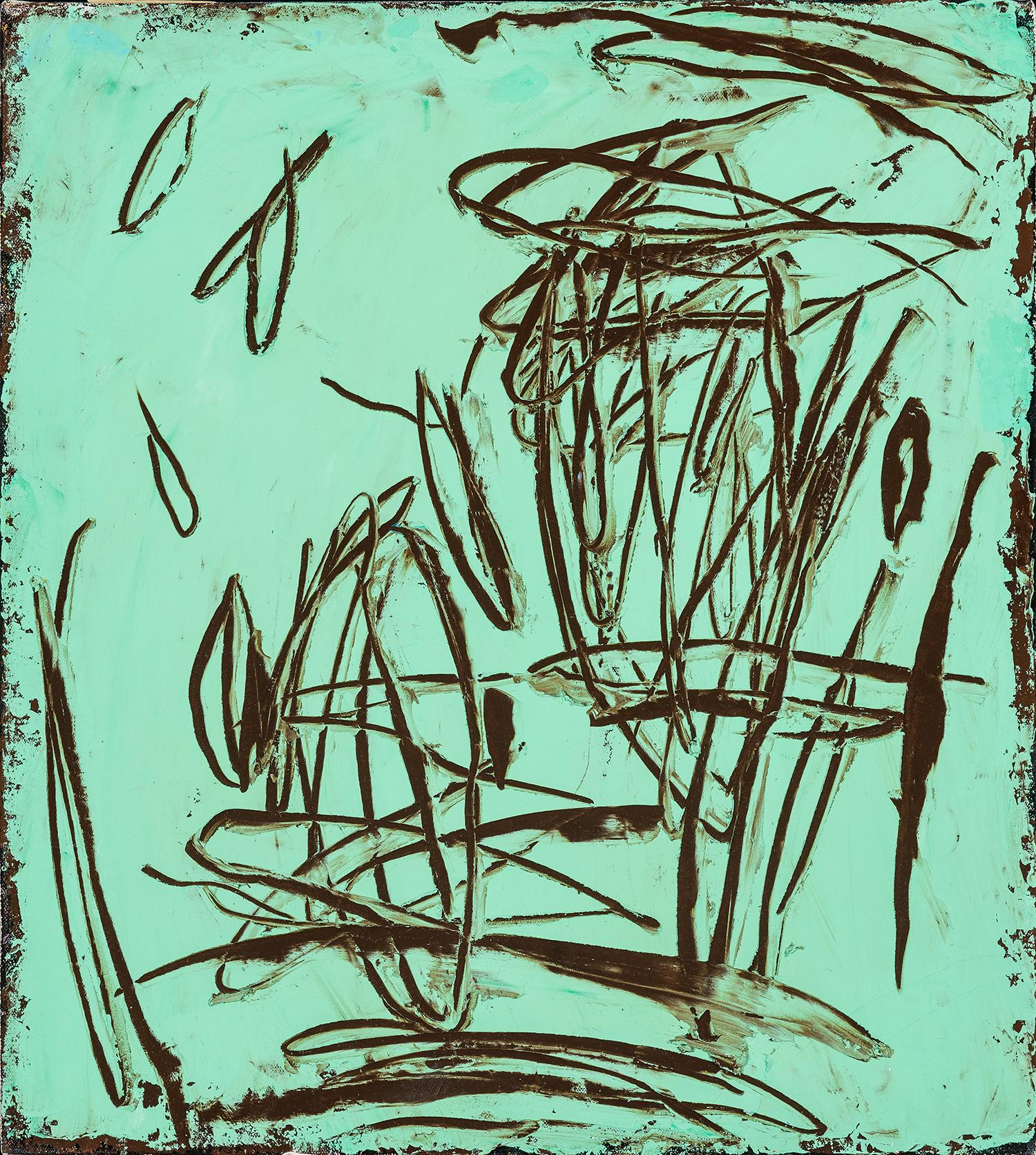Louisa ChaseUntitled1986-1987
1986-1987
About the Item
- Creator:Louisa Chase (1951 - 2016, American)
- Creation Year:1986-1987
- Dimensions:Height: 72 in (182.88 cm)Width: 72 in (182.88 cm)
- Medium:
- Movement & Style:
- Period:
- Condition:
- Gallery Location:New York, NY
- Reference Number:
Louisa Chase
Louisa Chase was born in Panama City, Panama. Seven years later, her family moved to Lancaster, Pennsylvania. She studied painting and sculpture at Syracuse University and at the Yale University School of Art. In 1975, she moved to New York and had her first solo show at Artists Space.
Chase was among the wave of Neo-Expressionists of the 1980s who rejected the detached, pared-down approach of Minimalism and Conceptualism in favor of a dynamic technique and the use of symbolic imagery in her paintings and prints. She has had numerous solo shows in New York, Los Angeles, and Toronto, and has participated in group exhibitions held in the United States and abroad, notably at the Daimaru Exhibition Hall in Osaka, Japan, the Cincinnati Art Museum, the Metropolitan Museum of Art, New York, and the American Pavilion at the Venice Biennale 1984.
In 1984, the Institute of Contemporary Art in Boston organized a traveling exhibition of Chase’s work, and in 1997 the Madison Art Center held a retrospective exhibition of her prints.
Chase is a recipient of grants from the National Endowment for the Arts in 1978–79 and 1982–83. She has taught at the Rhode Island School of Design, the School of Visual Arts in New York, and at the Skowhegan School of Painting and Sculpture in Maine.
Chase’s work can be found in major public collections across the country, including the Brooklyn Museum of Art; the Albright-Knox Art Gallery, Buffalo, New York; the Denver Art Museum, Colorado; the Nelson-Atkins Museum of Art, Kansas City the Madison Art Center, Wisconsin; the Walker Art Center, Minneapolis; the Museum of Modern Art, New York; The Metropolitan Museum of Art, New York; the New York Public Library; the Whitney Museum of American Art, New York; and the Corcoran Gallery of Art, Washington, D.C.
(Biography provided by Diane Villani Editions)
- ShippingRetrieving quote...Ships From: New York, NY
- Return PolicyThis item cannot be returned.
- UntitledBy Louisa ChaseLocated in New York, NYOil on canvas, 11 x 10 in.Category
Late 20th Century American Modern Abstract Paintings
MaterialsCanvas, Oil
- UntitledBy Louisa ChaseLocated in New York, NYSigned and dated (on verso): Louisa Chase 1985Category
Late 20th Century American Modern Abstract Paintings
MaterialsCanvas, Oil
- UntitledBy Louisa ChaseLocated in New York, NYSigned and dated (on verso): Louisa Chase 1982Category
Late 20th Century American Modern Abstract Paintings
MaterialsCanvas, Oil
- No. 3 -1960By Stanley TwardowiczLocated in New York, NYSigned (on stretcher): Stanley Twardowicz Stanley Twardowicz (1917–2008), a one-time orphan, Golden Gloves boxer, professional baseball player and auto worker, emerged from a hards...Category
Late 20th Century American Modern Abstract Paintings
MaterialsEnamel
- Yours TrulyBy Arthur DoveLocated in New York, NYYours Truly is a work of 1927, a fertile year for Dove, capped by a solo exhibit at Stieglitz’s “The Intimate Gallery,” which included this picture. From 1924 through 1930, Dove produced a notable series of collages, interspersed with drawings, pastels, and oil paintings on a variety of supports. In 1927, the same year that Dove painted Yours Truly, he found inspiration in American popular music, often referring in his titles to works by George Gershwin and Irving Berlin. Yours Truly was the title of a Broadway musical that opened at the Shubert Theater on January 25, 1927. Gene Buck, the producer, had collaborated with Raymond Hubbell, the composer, on the Ziegfield Follies shows of 1923, 1924, and 1925. The production, which contained the title song, “Yours Truly,” ran for 127 performances, closing on May 14, 1927. Given the context of Dove paintings...Category
1920s American Modern Paintings
MaterialsOil, Canvas
- UntitledBy Louisa ChaseLocated in New York, NYLouisa Lizbeth Chase was born in 1951 to Benjamin and Wilda Stengel Chase in Panama City, Panama, where her father, a West Point graduate, was stationed. The family moved to Pennsylv...Category
20th Century American Modern Abstract Paintings
MaterialsCanvas, Wax, Oil
- Modernist Abstract Expressionist Watercolor Painting Bauhaus Weimar Pawel KontnyBy Pawel KontnyLocated in Surfside, FLAbstract watercolor composition bearing the influence of the earlier color-block compositions of Paul Klee. Pawel August Kontny, (Polish-German-American artist) He was born in Laurahuette, Poland, in 1923, the son of a wealthy pastry shop owner. In 1939 he began studying architecture in Breslau where he was introduced to the European masters and to the work of some of the German Expressionists, soon afterward banned as "degenerate artists" and removed from museums throughout Germany by the Nazi regime. His studies were interrupted by World War II. Drafted into the German army, traveling in many countries as a soldier, he sketched various landscapes but in 1945, he was captured and held as a prisoner of war in Italy. After the war, he studied at the Union of Nuremberg Architects to help design buildings to replace ones destroyed in the war. He recorded his impressions of the local population and the landscapes through his watercolors and drawings. Pawel Kontny thereafter moved to Nuremberg, Germany, becoming a member of the Union of Nuremberg Architects and helping to rebuild the city's historic center. He soon decided to concentrate on his professional art career. He married Irmgard Laurer, a dancer with the Nuremberg Opera. Pavel Kontny 's career as an artist was launched with his participation in an all German exhibition, held at the Dusseldorf Museum in 1952. He held one-man shows in Germany, Switzerland and the United States. During his trip to the United States in 1960, Kontny became instantly enamored with Colorado, and decided to relocate to Cherry Hills with his wife and two children. He quickly established himself in the local art community, being affiliated for a time with Denver Art Galleries and Saks Galleries. His subject matter became the Southwest. During this time he received the Prestigious Gold Medal of the Art Academy of Rome. His extensive travel provided material for the paintings he did using his hallmark marble dust technique. he also worked equally in pastel, watercolor, charcoal and pencil-and-ink. in a style which merged abstraction and realist styles, influenced by Abstract Expressionist painting and South Western American landscapes. In the early 1960s he was one of only a few European-born professional artists in the state, a select group that included Herbert Bayer (1900-1985), a member of the prewar Bauhaus in Weimar and Dessau, Germany, and Roland Detre (1903-2001), a Hungarian modernist painter. As a Denver, Colorado resident, Pavel Kontny exhibited at galleries and museums throughout the United States, Germany and Japan. There, he was inspired by frequent trips to Native American pueblos in the Southwest, as well as by the study of the Plains Indians of Montana and Wyoming. Over the years Kontny had a number of students and generously helped young artist by hosting exhibitions at his Cherry Hills home. For many years he generously donated his paintings to support charitable causes in Denver. Influences during his European years included German pastelist C.O. Muller, German Informel painter Karl Dahmen and Swiss artist, Hans Erni. In the early 1950s his painting style showed the influence of the Die Brücke (The Bridge), a group of German expressionist artists formed in Dresden in 1905 who had a major impact on the evolution of modern art in the twentieth century in Germany. By the middle of the decade his style incorporated more referential abstraction and total abstraction, resulting in part from his study of Hans Hartung, a German artist based in Paris who exhibited his gestural abstract work in Germany. The American moon landing in 1969 inspired Paul Kontny...Category
20th Century American Modern Landscape Paintings
MaterialsCanvas, Oil
- Abstract HorizontalLocated in Missouri, MOKen Anderson (20th century) was active/lived in United States. Ken Anderson is known for Abstract hanging sculpture. *See included images and videoCategory
1980s American Modern Abstract Paintings
MaterialsCanvas, Wood, Mixed Media, Oil, Handmade Paper
- Falling Man, Black on White BackgroundBy Ernest Tino TrovaLocated in Missouri, MOFalling Man, Black on White Background by Ernest Tino Trova. 52.5" x 52.5" Known for his Falling Man series in abstract figural sculpture, he created ...Category
Late 20th Century American Modern Abstract Paintings
MaterialsCanvas, Oil
- Reclining FiguresBy Otis HubandLocated in Dallas, TXBorn in 1933, Otis Huband declared his intention to be an artist at age 6. He earned his BFA and MFA at Richmond Professional Institute of the College of William & Mary, now Virginia...Category
2010s American Modern Abstract Paintings
MaterialsCanvas, Oil
- The Dance of Salome, Abstracted Figural Framed Triptych, 1960s Oil PaintingsBy Edward MarecakLocated in Denver, COThe Dance of Salome or the Dance of the Seven Veils is a Triptych painted in 3 panels in oil on board. Each panel depicts a semi-abstract, cubist style individual figure: Herod, Herodias and Salome. Painted in bright colors of yellow, orange, red, green, fuchsia, purple, pink, white, blue, black and brown. Presented in vintage frames, framed dimensions of each panel measure 29 x 17 x 1 ½ inches, Image size is 23 ½ x 12 ¼ inches, each. Overall dimensions of the triptych measure 29 x 53 ½ x 1 ½ inches as displayed with 1 inch spacing between each panel. Based on the Dance of Seven Veils in which Princess Salome danced...Category
1960s American Modern Portrait Paintings
MaterialsCanvas, Oil
- Abstract Composition with Square and Rods in Oil on CanvasLocated in Soquel, CAAbstract Composition with Square and Rods in Oil on Canvas Bold abstract composition by B. Chapman (20th Century). This piece is made up of dark, rich colors, with objects assembled...Category
1980s American Modern Abstract Paintings
MaterialsCanvas, Oil, Stretcher Bars, Other Medium
Recently Viewed
View AllRead More
With Works Like ‘Yours Truly,’ Arthur Dove Pioneered Abstract Art in America
New York gallery Hirschl & Adler is exhibiting the bold composition by Dove — who’s hailed as the first American abstract painter — at this year’s Winter Show.
Remarkably, Elizabeth Turk’s Sculptures Highlight the Lost Voices of Extinct Birds
In one of the first live and in-person exhibitions at a Manhattan gallery since last spring, the California-based sculptor gives the lost voices of endangered and extinct birds and animals a magnificent embodied form.






